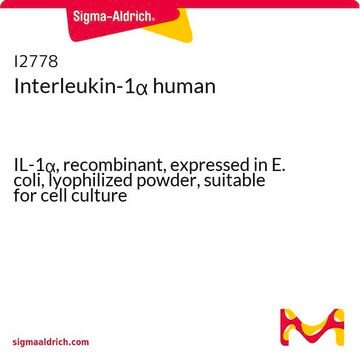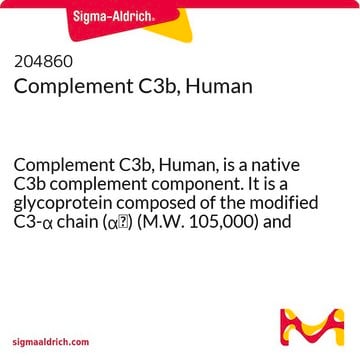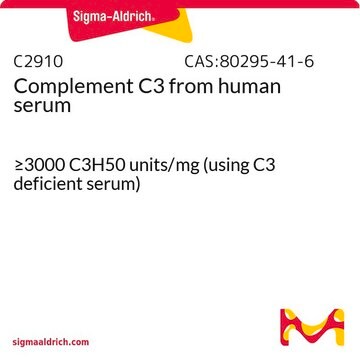204876
Complement C1q, Human
Complement C1q, Human, CAS 80295-33-6, is a native C1q complement component composed of 18 polypeptide chains consisting of three nonidentical A, B, C subunits of 29, 26, and 19 kDa, respectively.
Synonyme(s) :
Complement C1q, Human
Se connecterpour consulter vos tarifs contractuels et ceux de votre entreprise/organisme
About This Item
Produits recommandés
Niveau de qualité
Pureté
≥90% (SDS-PAGE)
Forme
liquid
Fabricant/nom de marque
Calbiochem®
Conditions de stockage
OK to freeze
avoid repeated freeze/thaw cycles
Impuretés
IgG, IgA, IgM, C3, C4, albumin, fibrinogen, α₂-macroglobulin, trace
Conditions d'expédition
wet ice
Température de stockage
−70°C
Description générale
Native, human C1q complement component. Glycoprotein composed of 18 polypeptide chains consisting of three nonidentical subunits A, B, and C, of M.W. 29,000, 26,000 and 19,000, respectively. Present in normal human serum at 70 µg/ml. Found in circulating blood plasma complexed with two C1r and two C1s molecules to form the first component of complement (C1). Activation of complement via classical pathway is triggered by binding of C1q to immune complexes containing IgG or IgM or to a variety of other activating substances, including C-reactive protein, retroviruses, and mitochondria. Subsequent to C1q binding, C1r and C1s are converted to proteolytic enzymes that are responsible for continuation of activation via the classical pathway.
Native, human C1q complement component. Glycoprotein composed of 18 polypeptide chains consisting of three nonidentical subunits, A, B, and C, of M.W. 29 kDa, 26 kDa, and 19 kDa, respectively. Present in normal human serum at 70 µg/ml. Found in circulating blood plasma complexed with two C1r and two C1s molecules to form the first component of complement (C1). Activation of complement via classical pathway is triggered by binding of C1q to immune complexes containing IgG or IgM or to a variety of other activating substances, including C-reactive protein, retroviruses, and mitochondria. Subsequent to C1q binding, C1r and C1s are converted to proteolytic enzymes that are responsible for continuation of activation via the classical pathway.
Actions biochimiques/physiologiques
≥150,000 C1qH50 units/mg and ≥70% C1q activity in normal human serum on a mg/mg basis
Conditionnement
Please refer to vial label for lot-specific concentration.
Avertissement
Toxicity: Standard Handling (A)
Forme physique
In 300 mM NaCl, 10 mM HEPES, 40% glycerol, pH 7.2.
Notes préparatoires
Prepared from serum that has been shown by certified tests to be negative for HBsAg and for antibodies to HIV and HCV.
Reconstitution
Following initial thaw, aliquot and freeze (-70°C).
Autres remarques
Loos, M., et al. 1980. J. Immunol. 124, 59.
Kolb, W.P., et al. 1979. J. Immunol. 122, 2103.
Kolb, W.P., et al. 1979. J. Immunol. 122, 2103.
Informations légales
CALBIOCHEM is a registered trademark of Merck KGaA, Darmstadt, Germany
Code de la classe de stockage
10 - Combustible liquids
Classe de danger pour l'eau (WGK)
WGK 2
Certificats d'analyse (COA)
Recherchez un Certificats d'analyse (COA) en saisissant le numéro de lot du produit. Les numéros de lot figurent sur l'étiquette du produit après les mots "Lot" ou "Batch".
Déjà en possession de ce produit ?
Retrouvez la documentation relative aux produits que vous avez récemment achetés dans la Bibliothèque de documents.
Les clients ont également consulté
Notre équipe de scientifiques dispose d'une expérience dans tous les secteurs de la recherche, notamment en sciences de la vie, science des matériaux, synthèse chimique, chromatographie, analyse et dans de nombreux autres domaines..
Contacter notre Service technique












